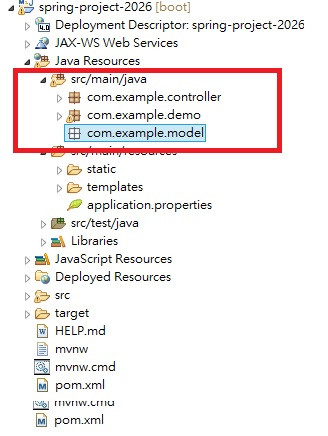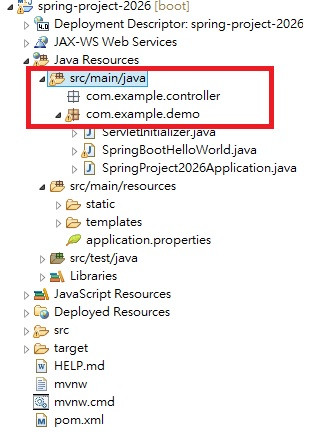在Day8提到建立MySQL數據庫,相信大家都成功做到。同一時間在過去的幾天,大家對Spring Boot的認識也多了一些,接下來就是和大家講一下怎樣在Spring Boot連接MySQL數據庫。
由於今天的教學需要建立各種檔案,所以大家需要多花時間來閱讀及完成練習。
詳細可以去Day 8的教學看看
今天的教學會使用的數據庫的表格如下:
use sys;
CREATE TABLE `staffInfo` (
`ID` int(11) NOT NULL AUTO_INCREMENT,
`EMAIL` varchar(40) COLLATE utf8_unicode_ci DEFAULT NULL,
`PASSWORD` varchar(45) COLLATE utf8_unicode_ci DEFAULT NULL,
`POSITION` varchar(45) COLLATE utf8_unicode_ci DEFAULT NULL,
`PHONE` varchar(45) COLLATE utf8_unicode_ci DEFAULT NULL,
`CREATE_DATE` datetime DEFAULT NULL,
PRIMARY KEY (`ID`)
)
在< dependencies > </dependencies>之間加入下面的代碼
<!-- For DataBase connection -->
<dependency>
<groupId>mysql</groupId>
<artifactId>mysql-connector-java</artifactId>
<scope>runtime</scope>
</dependency>
<!-- For DataBase connection -->
<dependency>
<groupId>org.springframework.boot</groupId>
<artifactId>spring-boot-starter-jdbc</artifactId>
</dependency>
最終的完整代碼是:
<?xml version="1.0" encoding="UTF-8"?>
<project xmlns="http://maven.apache.org/POM/4.0.0" xmlns:xsi="http://www.w3.org/2001/XMLSchema-instance"
xsi:schemaLocation="http://maven.apache.org/POM/4.0.0 https://maven.apache.org/xsd/maven-4.0.0.xsd">
<modelVersion>4.0.0</modelVersion>
<parent>
<groupId>org.springframework.boot</groupId>
<artifactId>spring-boot-starter-parent</artifactId>
<version>2.1.8.RELEASE</version>
<relativePath/> <!-- lookup parent from repository -->
</parent>
<groupId>com.example</groupId>
<artifactId>spring-project-2026</artifactId>
<version>0.0.1-SNAPSHOT</version>
<packaging>war</packaging>
<name>spring-project-2026</name>
<description>Demo project for Spring Boot</description>
<properties>
<java.version>1.8</java.version>
</properties>
<dependencies>
<dependency>
<groupId>org.springframework.boot</groupId>
<artifactId>spring-boot-starter-web</artifactId>
</dependency>
<dependency>
<groupId>org.springframework.boot</groupId>
<artifactId>spring-boot-starter-tomcat</artifactId>
<scope>provided</scope>
</dependency>
<dependency>
<groupId>org.springframework.boot</groupId>
<artifactId>spring-boot-starter-test</artifactId>
<scope>test</scope>
</dependency>
<!-- Template Engine -->
<dependency>
<groupId>org.springframework.boot</groupId>
<artifactId>spring-boot-starter-thymeleaf</artifactId>
</dependency>
<!-- For DataBase connection -->
<dependency>
<groupId>mysql</groupId>
<artifactId>mysql-connector-java</artifactId>
<scope>runtime</scope>
</dependency>
<!-- For DataBase connection -->
<dependency>
<groupId>org.springframework.boot</groupId>
<artifactId>spring-boot-starter-jdbc</artifactId>
</dependency>
</dependencies>
<build>
<plugins>
<plugin>
<groupId>org.springframework.boot</groupId>
<artifactId>spring-boot-maven-plugin</artifactId>
</plugin>
</plugins>
</build>
</project>
JDBC(Java Database Connectivity)是一種規範(API),是Java語言中用來規範用戶端程式怎樣存取數據庫的應用程式介面,提供查詢和更新資料庫中資料等的方法。所以當建立一個數據庫連線時,除了加入有關數據庫的類型的依賴還要加入為Java存取數據庫的應用程式介面的依賴。
# For MySQL connection
spring.datasource.url=jdbc:mysql://localhost:3306/sys?serverTimezone=UTC&useSSL=false
spring.datasource.username=root
spring.datasource.password=root
spring.datasource.driver-class-name=com.mysql.cj.jdbc.Driver
spring.http.encoding.force=true
最終的完整代碼是:
spring.thymeleaf.prefix=classpath:/templates/
spring.thymeleaf.suffix=.html
# For MySQL connection
spring.datasource.url=jdbc:mysql://localhost:3306/sys?serverTimezone=UTC&useSSL=false
spring.datasource.username=root
spring.datasource.password=root
spring.datasource.driver-class-name=com.mysql.cj.jdbc.Driver
spring.http.encoding.force=true
解釋:
localhost:3306 是數據庫的port位置,預設是3306,可以根據不同情況去修改的。
sys 是數據庫的名稱(注意不是資料表的名稱而是數據庫的名稱,數據庫可以有很多。(假設你的數據庫的名稱是hellodatabase, 那在localhost:3306/後面就填上” hellodatabase”。(就變成jdbc:mysql://localhost:3306/hellodatabase)
在問號後面是各種參數的值,如果大家和我一樣都是用MySQL,就必須要包括以下兩個參數。
serverTimezone=UTC&useSSL=false
serverTimezone 是一個和時區有關的,而UTC是全球標準時間,可以根據你的時區選擇合適的值。
useSSL是指需不需要SSL連線,必須要包括這參數的值,否則會報錯。
而它的值選擇useSSL=false就可以。
負責資料的收集或提取
完整代碼:
package com.example.model;
import org.springframework.stereotype.Component;
@Component
public class StaffModel {
private int id;
private String email;
private String phone;
private String password;
private String position;
public int getId() {
return id;
}
public void setId(int id) {
this.id = id;
}
public String getEmail() {
return email;
}
public void setEmail(String email) {
this.email = email;
}
public String getPhone() {
return phone;
}
public void setPhone(String phone) {
this.phone = phone;
}
public String getPassword() {
return password;
}
public void setPassword(String password) {
this.password = password;
}
public String getPosition() {
return position;
}
public void setPosition(String position) {
this.position = position;
}
}
負責與數據庫溝通,需要運用SQL語言來操作CRUD。
完整代碼:
package com.example.repository;
import org.springframework.beans.factory.annotation.Autowired;
import org.springframework.jdbc.core.JdbcTemplate;
import org.springframework.stereotype.Repository;
import com.example.model.StaffModel;
@Repository
public class StaffRepository {
@Autowired
private JdbcTemplate jdbcTemplate;
public void addStaff(StaffModel staffModel){
System.out.println("EXCUTE INSERT MEMBER");
jdbcTemplate.update("INSERT INTO staffInfo(PASSWORD, EMAIL, POSITION, PHONE, CREATE_DATE) "
+ "VALUES (?,?,?,?,NOW())",staffModel.getPassword(), staffModel.getEmail(),
staffModel.getPosition(),staffModel.getPhone());
}
}
負責簡化代碼,在這裡建立各種CRUD的指令。
完整代碼:
package com.example.service;
import org.springframework.beans.factory.annotation.Autowired;
import org.springframework.stereotype.Service;
import com.example.model.StaffModel;
import com.example.repository.StaffRepository;
@Service
public class StaffService {
@Autowired
StaffRepository staffRepository;
public void addStaff(StaffModel staffModel){
staffRepository.addStaff(staffModel);
}
}

在src/main/java底下創建新的package叫com.example.controller
負責做各種mapping,如果在url找到相應用的mapping就會執行。
完整代碼:
package com.example.controller;
import org.springframework.beans.factory.annotation.Autowired;
import org.springframework.web.bind.annotation.RequestMapping;
import org.springframework.web.bind.annotation.RestController;
import com.example.model.StaffModel;
import com.example.service.StaffService;
@RestController
public class StaffController {
@Autowired
StaffModel staffModel;
@Autowired
StaffService staffService;
@RequestMapping("/addStaff")
public String hello(){
staffModel = new StaffModel();
staffModel.setPassword("1234");
staffModel.setEmail("email@email.com");
staffModel.setPhone("22334455");
staffModel.setPosition("Manager");
staffService.addStaff(staffModel);
return "New Staff added";
}
}
要運用@ComponentScan把所有相關的package都加在括號內
還有@EntityScan,把所有相關的package都加在括號內
目的是讓系統去檢查各個package的檔案。
完整代碼:
package com.example.demo;
import org.springframework.boot.SpringApplication;
import org.springframework.boot.autoconfigure.SpringBootApplication;
import org.springframework.boot.autoconfigure.domain.EntityScan;
import org.springframework.boot.web.servlet.support.SpringBootServletInitializer;
import org.springframework.context.annotation.ComponentScan;
@SpringBootApplication
@ComponentScan({"com.example.demo","com.example.model","com.example.controller","com.example.service","com.example.repository"})
@EntityScan({"com.example.demo","com.example.model","com.example.controller","com.example.service","com.example.repository"})
public class SpringProject2026Application extends SpringBootServletInitializer {
public static void main(String[] args) {
SpringApplication.run(SpringProject2026Application.class, args);
}
}
http://localhost:8080/spring-project-2026/addStaff
如果成功會出現以下畫面:
開啟MySQL數據庫,檢查有沒有新的資料寫進數據庫中的staffInfo。
參考文章/網站/書本:

請問 我執行到最後一個步驟 執行spring boot 應用程式
之後進入http://localhost:8080/spring-project-2020/addStaff (我專案改成2020)
可是進入之後出現這個畫面
請問是環境設定錯了還是程式碼的部分有問題呢?
痾 解決了 可是我也不知道為什麼解決了
我把StaffController.java移到跟SpringProject2020Application.java同一個package
之後又移回到原本的package裡就突然可以了
另外我想問一下
run on server用Tomcat做連結 跟 用spring boot app 這兩個是差在哪裡
我用前者不會出現上方的錯誤 用下方的話就會
是因為沒有透過Tomcat 去跟MySQL做連結的關係嗎?
當spring boot 執行我記得tomcat 就會自己起了我記得是這樣
有誤的話可以糾正我一下XD
我也碰到同樣的問題,我的 Sever Tomcat failed to stop 了,請問有大大可以替小弟解釋一樣可能會 failed 的原因嗎?
如果說這一段有報錯的
<!-- For DataBase connection -->
<dependency>
<groupId>mysql</groupId>
<artifactId>mysql-connector-j</artifactId>
<scope>runtime</scope>
</dependency>
<!-- For DataBase connection -->
<dependency>
<groupId>org.springframework.boot</groupId>
<artifactId>spring-boot-starter-jdbc</artifactId>
</dependency>